While messing around with monster creation, I started comparing 5e Monster Manual creatures with the 5e guidelines for creating monsters (DMG page 274). Based on my number crunching, it looks like the DMG’s central monster creation chart, “Monster Statistics by Challenge Rating”, isn’t in line with the Monster Manual, and if you try to follow it you will get monsters that don’t look much like Monster Manual monsters.
This may be widely known and only new to me, but I haven’t found anything definitive or official on it. A fairly cursory search only turns up a few argumentative message board discussions and some pretty good Howling Tower posts (such as https://koboldpress.com/howling-tower-monster-stats-part-2/ where Steve Winter graphs the discrepancies but backs off the conclusion that the DMG chart is incorrect.
In this post, I’ll try to show the data that suggests to me that the chart is wrong.
Note: the process of creating a monster stat block is long and convoluted: according to the DMG it’s a 20-step process (!) and one of the steps involves executing another 4-step process detailed elsewhere. So there’s lots of room for error, and I could have a lot of things wrong. But the basic process is: figure out the monster’s Defensive CR, which is primarily determined by HP but modified by AC, resistances, and some traits; figure out its Offensive CR, which is primarily determined by average damage over three rounds of combat, modified for burst damage, area of effects, and various traits and abilities, and also by attack bonus or spell save DC; and then average the offensive and defensive numbers to get the final CR.
Hit Points
The first clue that the DMG chart is wrong is in the hit points column of the chart. According to the chart, for instance, a CR 1/4 monster has 36-49 HP. However, let’s look at some CR 1/4 monster hit points. Boar, 11 HP. Goblin, 7 HP. Skeleton, 13 HP. Wolf, 11 HP. The CR 1/4 monster with the highest HP is the mud mephit, with 27 HP, still significantly less than the low end of the DMG-suggested hit point range.
Here’s a chart of the DMG-suggested Hit Points versus the average hit points per level from the Monster Manual: purple bar is the DMG’s Hit Point recommendations by CR, blue bar is the actual average HP from the Monster Manual.
That weird dip at CR 18 is because the demilich is the only CR 18 monster. And in fact, there are so few data points above level 10 that any analysis above level 10 should be taken with a grain of salt. Even ignoring the demilich and the dearth of high level data, you can see that the Monster Manual Hit Points skew way low.
The DMG monster creation rules have lots of adjustments to be made: monsters with lots of resistances and immunities are to have their “effective HP” adjusted upwards; and defensive abilities, such as damage transfer, regeneration, or magic resistance also adjust the effective HP. However, on examination, these adjustments don’t actually account for the extra HP in the DMG chart. In fact, they don’t do much at all. Examine the following chart:
In the chart above, “mm no defenses” means those monsters with few resistances and no significant defensive abilities. You’d expect these monster to have the highest hit points. “mm low resistance” are the monsters with few resistances, whether or not they have defensive abilities. “mm high resistance” means those monsters with more than 3 resistances or immunities: you’d expect these monsters to have the lowest hit points. (Many of these bars are broken because there are CRs at which there are no monsters which meet these qualifications.)
In fact, below level 12 – where we have enough data points to do reasonable analysis – there are no significant hit point differences between monsters with high special defenses/resistances/immunities and those without. At high levels, it is plausible that high-immunity monsters may have lower hit points, though we really need more data points to be sure. However, the overall trend lines are clear: none of these groups of monsters has anything like the hit point totals recommended in the DMG – even the no-defense brutes.
Conclusion: In the Monster Manual, hit points are much lower than the values presented in the DMG. Furthermore, special defenses, resistances and immunities don’t seem to be related to hit points.
Armor Class
Now let’s add armor class into the analysis. In the DMG, hit points and armor class are both used to determine “defensive CR” so perhaps it doesn’t make sense to analyze one without the other.
First of all, a simple analysis of real Monster Manual AC versus expected DMG AC.
Apart from high levels, Monster Manual and DMG ACs are close: usually within a point of AC.
Could Armor Class solve our Hit Point problems? Perhaps low-AC monsters have proper DMG Hit Point values?
Here is a chart of the average hit points of monsters grouped by AC.
“Low ac hp” is HP of the monsters with AC lower than the DMG AC value. You’d expect these guys to have high hit points. “High ac hp” have higher than average AC and theoretically should have lower than average hit points. “Target HP” are the monsters whose AC exactly matches the DMG AC expectations.
As you can see, below level 11, there is no significant difference in HP between those monsters with high and low HP. Above level 11, things are swingy as usual because of fewer data points, but there is no obvious through line that suggests that there is any relationship between AC and HP.
Conclusion: In the Monster Manual, AC values are on par with those presented in the DMG. Hit points and AC do not seem to be correlated in any meaningful way.
Damage
It takes quite a few steps to calculate a monster’s “average” damage according to the instructions in the Monster Manual. The process is: figure out the average damage for the first 3 rounds of combat. Assume that all monster attack hits and all hero saving throws fail. All area attacks hit two people, and all ongoing effects (like being swallowed) last for one turn. Effects like Charge or Pounce happen once.
After all these calculations, here are the Monster Manual average damages by CR, compared to the DMG expectations.
(The gap in the blue line is for the demilich, the only CR 18 monster, whose max damage is hard to calculate.)
The Monster Manual damage is fairly close to the DMG expectation, though generally 10% to 20% low. This is odd: Monster Manual hit points are too low according to the DMG rubric, and damage is low too? It seems as if Monster Manual monsters are just weaker than the DMG suggests. But let’s do some further analysis to damage.
Perhaps monsters have a higher “effective hit points” because of special attack modes. If this is the case, those monsters with special attack modes should have lower hit points than simple monsters. To test this, I’ll separate out those monsters with powerful attack modes that don’t do direct damage, like charm, stun, paralysis, and instakill abilities.
As usual, below level 11 where we have the most data, there is no damage difference between monsters with and without special attack modes. At high levels, there are variations, but there is no clear winner.
Maybe there is some relationship between damage and hit points? Perhaps monsters with lower hit points do higher damage, and vice versa?
To test this, I’ll graph the damage dealt by below-average-HP monsters and above-average-HP monsters separately.
Again, below level 11, there is no difference at all between the damage output of beefy and glass-jawed monsters, and at high levels the correlation isn’t clear. If anything, there may be a slight reverse correlation with beefier monsters doing more damage.
Conclusion: The damage output of Monster Manual monsters is slightly lower than the DMG expectations. It’s not correlated with special attack modes or with hit points.
Attack bonus
We have another important value to look at: attack bonus. How do the monster manual attack bonuses compare to the DMG values? And do they correlate to any other monster stats?
First of all, the attack bonus numbers:
Attack bonuses are WAY off. Monster Manual values are consistently too high compared to DMG values throughout – as much as 5 points too low at level 24 (+12 vs +17).
This is starting to make sense. I think the DMG values are an early draft of the monster formulae. I bet that at some point, the developers decided that they needed to raise the accuracy and lower the damage of monsters, aiming for the same total damage. The DMG chart never got updated.
While we’re here, let’s just check for a few more correlations. Do high-accuracy monsters have lower damage output, or have fewer hit points? My guess is no, since we’ve hardly found any correlations yet.
Not only does attack not balance anything out, there may be a reverse correlation: hi-accuracy monsters also tend to be slightly higher-damage and higher-hit point than normal. In other words, within a given CR, some monsters are better all-round than others.
Conclusion: Attack bonus in the Monster Manual is way lower than in the DMG chart, and doesn’t correlate with any other monster attributes.
Save DC
Since we’ve come this far, we might as well look at the last column in the DMG chart: save DC.
The save DCs in the Monster Manual are quite different from those in the DMG chart. The DMG DCs are much flatter, ranging from 13 to 23, while the actual DCs range from 10 to 24. I don’t think I need to do a lot of analysis on DCs.
Now what?
It seems clear to me that the Monster Statistics by Challenge Rating isn’t the up-to-date version of the monster creation formulae. I bet it was accurate as of some iteration of D&D Next and never got fully updated.
It’s also apparent that there is not a lot of correlation between any monster stat and any other stat. All the complicated DMG steps involving adjusting and averaging don’t actually hold up to examination when we look at the Monster Manual monsters. The actual process seems to be something like
1. Start with appropriate numbers based on CR
2. Adjust any stat or two up and down, and add any trait or feature, based on story. Don’t make any further adjustments.
Which is great for us! This two-step system is way easier than the 20-step DMG version. We can even do it on the fly! All we need is an accurate CR-to-statistics chart.
Give me a few days: I’ll try to come up with a new monster-creation chart that will match Monster Manual monster math, and that is small enough to fit, say, on a business card.
In the meantime, here is a copy of the monster-stat TSV file I used to generate these tables. Please feel free to validate the monster stats, validate or invalidate my calculations, correct my assumptions, prove me wrong, or whatever else you want to do with this stuff.


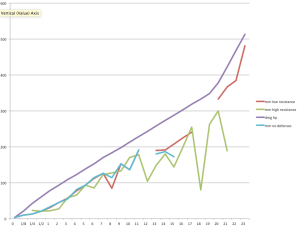
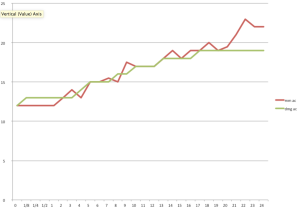

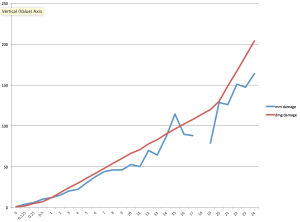
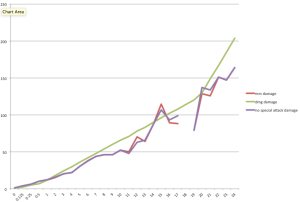


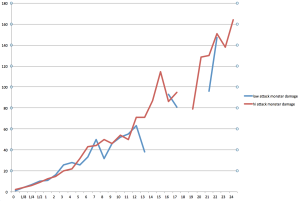
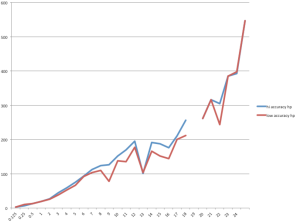
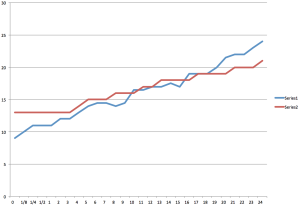







This is great. I thought I was going crazy thinking the MM monsters were too weak. I always end up scaling them up pretty much according to your 2 step process. I typically adjust AC Up just a hair and add about 20% more HP and add a couple of flavor abilities. Sometimes I’ll just add an immunity to nonmagical attacks and that’s enough.
Thanks for this analysis.
Interesting read. I noticed fairly early on that the monster building rules in the DMG pretty much don’t match up with the MM at all.
However I think it’s the other way around from what you suggest – the MM was a product of early playtesting individual monsters where as the DMG’s system is what the actual numbers should be. There’s a fair number of complaints about how the Encounter Building makes Encounters too easy, if used with the MM monsters. If the numbers in the DMG are used instead then encounters become a proper challenge. (Or on occasion far too much of a challenge.)
Newer monster from Volo’s or Mordenkainen’s seem to be closer to the DMGs system than the MM.
The monster design rules are horribly over complicated and some of the calculations affect each other. like calculating Proficiency based on CR, which is affected by Attack chance, which is affected by Proficiency. I very much look forward to seeing your new system.
If you look at the page before the Creating a Monster Stat Block, the 2 step guideline is there. Pick a CR, adjust, flavor, and voi là. Now with the difference of power between the DMG and the MM, I think the actual question is that the MM is more player friendly, which is an overall approach of the system, and it was the first monster book, it is expected that they would proceed with caution, tuning in the long range, as we have seen in the other books. One last point I consider, is that it seemed to me you got the average HP, if you had worked with the min and max HP of the creatures, results would be different.
I did not read the other articles your wrote on this topic. Maybe you have found out new stuff about the mechanics of monster creation.
I don’t understand the methodology you’re using here. The DMG outright tells you that you can trade offensive CR for defensive CR and vice versa, and defensive CR is a tradeoff between HP/AC/saves/etc.
You’re trying to prove that the DMG formula is wrong by graphing a bunch of individual inputs into the CR formula against the MM CR ratings… but shouldn’t you instead be graphing the _OUTPUTS_ from the CR formula?
Otherwise the only thing you’re doing is proving that the MM writers have a bias (e.g. towards high-AC, low-damage monsters) but are nevertheless following the DMG formulas.
I want to make it known that the average HP may not be what they use to calculate the expected HP of the monster. They may assume max HP for the monster in the formula. Damage does assume average dice rolls but there is no talk of average in the HP section.
Sorry, Will. You’re wrong. It’s actually that alot of monsters have features, traits, and abilities that subtly increase the effective damage, hp, and CR. If you follow the CR religiously using a MM monster, you’ll find most of them are within the exact CR range
It does seem as though, considering the DMG table has really high HP and the MM has high attack bonus, and lower than suggested total stats that
A) The table expects that most monsters will derive their CR primarily from offense, not defense. It takes a lot of HP to shift a monsters CR. A creature with equal offensive and defensive CR would be a tank, potentially a boss, and not terribly dangerous on it’s own.
And B) The DMG table is only for the simplest of monsters, and the more that a creature derives it’s danger from ANYTHING else, including traits, resistances, spells or even just speed, flight, swimming, or ranged attacks, the harder and more pointless it’s going to be to compare it to the DMG table with any accuracy.